4.1 Read About
| Site: | Cowichan Valley School District - Moodle |
| Course: | ELA6, CSS, Sferrazza |
| Book: | 4.1 Read About |
| Printed by: | Guest user |
| Date: | Sunday, 14 December 2025, 3:05 PM |
Table of contents
- Introduction to Poetry
- 4.1A How Do You Know It's a Poem?
- 4.1B How to Infer and How to Read a Poem
- 4.1C Free Verse & Show Don't Tell - A Creativity Lesson
- 4.1D Show Don't Tell - Journey to the Fishing Grounds
- 4.1E Creative Ways to Express Ideas: Simile and Metaphors
- 4.1F The Wendigo
- 4.1G Fossils and Creative Tools: Alliteration, Onomatopoeia, & Personification
- 4.1H The Great Water Giant
- 4.1I Building Creative Thinking Through Limericks
- 4.1J Quatrains
- 4.1K Building Creative Thinking Through Quatrains
Introduction to Poetry
Poets use language purposefully! EVERY word matters!!! That is part of why poetry is such a source of creativity and joy.
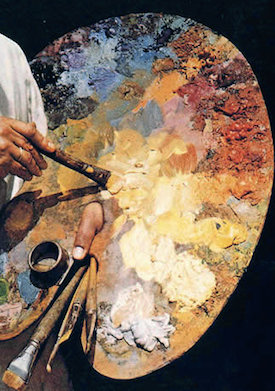 Poetry is images painted with words.
Poetry is images painted with words.
How? By using figurative language, sound, rhythm, and meaningful words.
Poetry uses purposefully powerful words to cause a reaction.
Poetry is art! Poetry is a song! Poets paint with words like artists use images on a canvas and musicians use music and lyrics to:
- express or describe emotions, events, people, or ideas
- explore relationships and culture, values and choices
- use language in unique ways
- play with sound by playing with words and line lengths/breaks and making intentional choices
- make comparisons to other things to understand them better
Poets invite us to read, explore, and devour the word pictures they have painted.
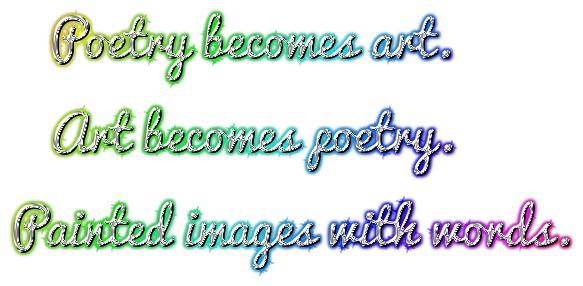
 |
Answer the question in your Learning Guide, How is poetry like art? Then, as you watch the video below, pause and complete the responses for "More Than Rhyme" in your Learning Guide. |
4.1A How Do You Know It's a Poem?
How do you know it's a poem?
Some poems have structure and some do not. Sometimes, a poem is divided into verses called stanzas. The following poem has 3 stanzas – each in a blue box. Notice the space (break) between the stanzas. That is how the reader knows one stanza is ending and another beginning. (Read the poem aloud. It is quite funny!)
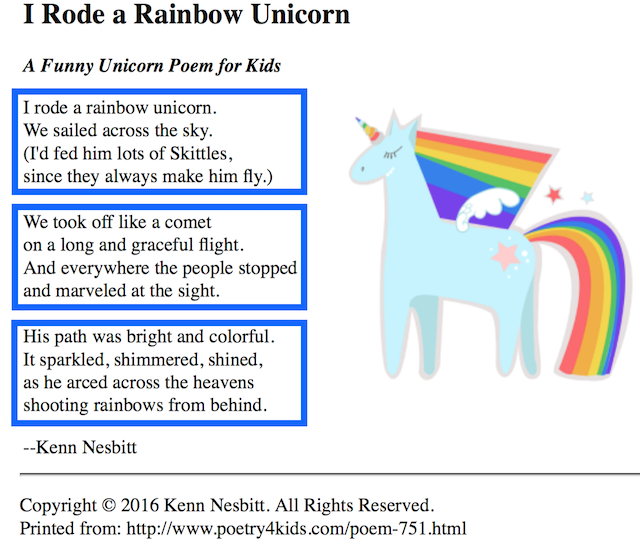
As you work through this lesson, you will read the following collection of poems about poems. Yes, you read that correctly - poems about poems! After each one, you will complete the responses for How Do You Know It's A Poem? in your Learning Guide, then return to this lesson. First, open the poems. Then follow along in this lesson with the reading and responses.:
1. Jeremy Bloom - Vital Question:
The first poem, Vital, is from a book by Gordon Korman in which a character named Jeremy Bloom mistakenly signs up for poetry class. Jeremy tackles the task of writing about homework, cleaning his room, measly allowances, and more.
 |
Read the poem and respond in your Learning Guide. |
2. What's a Poem?
Charles Ghighna, also known as "Father Goose" has written and published more than 100 books!
According to Charles Ghigna:
"You are a poet whenever you tell the world who you are, what you think, and how you feel. Finding poetry in the world and sharing it makes us all feel alive. It fills us with hope and wonder. It celebrates life. It shines light into the corners of the world and turns the overlooked and the common into little gems to behold. Poetry is everywhere! It’s in the smile of a friend and in the sound of the wind. It’s in the scent of the meadow and in the skyline of the city. It’s in the setting sun as she pulls her purple curtain across the backdrop of the world. Poetry is music, theater, dance, art and literature. Poetry is winter, spring, summer, and fall. Poetry is laughter and tears, faith and fears. Poetry is life!" (Source: http://charlesghigna.blogspot.ca/2010/07/poem-is-little-path-poems-about-poetry.html)
 |
Read the poem and respond in your Learning Guide. |
3. Inside a Poem
Author Eve Merriam wrote picture books and a number of books of poetry for children. Did you know you could win awards for poetry? In 1981, Eve Merriam was named the winner of an Award for Excellence in Poetry for Children.
Think about the following questions as you read, Inside a Poem.
- Do poems have to rhyme?
- Do they have a beat?
- Can you feel poetry?
- What phrases stand out?
 |
Read the poem and respond in your Learning Guide. |
4.1B How to Infer and How to Read a Poem
Poets are creative. Because of this, understanding poetry often requires the reader to make inferences (infer). An inference is an educated guess. Good readers infer as they read and they are willing to read something more than once – often even three times.
What does it mean to infer?
Readers like you figure out what the author is saying even though it might not be written down. Using background knowledge, clues from the text, illustrations, and captions, the reader makes meaning of the selection. It helps you understand text, as authors often imply (hint/suggest) themes and ideas, without actually stating them.
You are a sleuth! So, put on your detective hat and let's get started. You may be making an inference when you say:
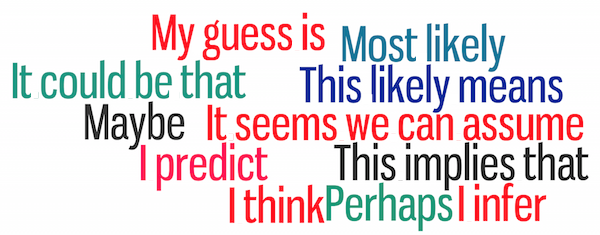
Can you use clues to infer the meaning of unknown words or phrases?
 |
Complete the "Use Clues to Infer" activity in your Learning Guide. Then, return to this online lesson. |
Poetry Reading Is A Skill
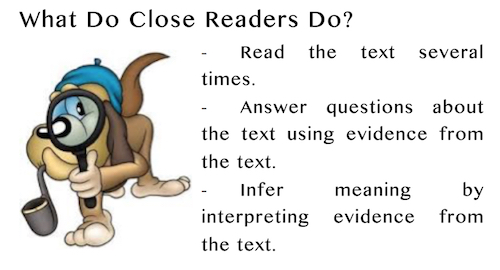
- First reading: Try to get the "gist" of the poem - a sense of what the poem is about and a sense of how it may be read.
- Second reading: This is usually a slower read, where you try to understand the poem better.
- Third+ reading: This reading may be to answer specific questions, unravel clues, and infer for deeper understanding. You can be a sleuth by going back to the details in the text to find evidence for your inferences.
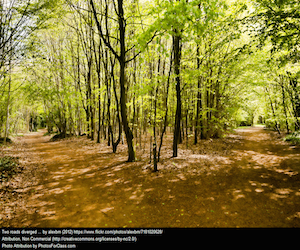
- Third+ reading: This reading may be to answer specific questions, unravel clues, and infer for deeper understanding. You can be a sleuth by going back to the details in the text to find evidence for your inferences.
- Second reading: This is usually a slower read, where you try to understand the poem better.
Road Not Taken - Poem
Have you ever found yourself "between a rock and a hard place" trying to make a difficult decision? Maybe you've had to choose between two equally good choices like playing soccer with one group of friends or going to a movie with your cousins. Sometimes, decisions are "bigger" and the outcomes last longer, like choosing guitar or piano lessons, community soccer or football. We've all had to face decisions where the "best choice" was not clear. The famous poet, Robert Frost, once wrote a poem that describes this feeling exactly.
The Road Not Taken, written in 1916, is one of his most famous poems. The poet tries to hook readers by presenting a difficult choice. By presenting a dilemma, he makes us want to read more.
Listen to the poem read by the author here, if you like, as you complete the "First Read" in your Learning Guide:
 |
Complete the responses and activities for "The Road Not Taken" activity in your Learning Guide. |
4.1C Free Verse & Show Don't Tell - A Creativity Lesson
 Don’t tell me the moon is shining; show me the glint of light on broken glass.
Don’t tell me the moon is shining; show me the glint of light on broken glass.
– Anton Chekhov
(Source: Goodreads)
What is meant by "Show, Don't Tell"?
You can tell your readers that:
The moon was shining,
or you can show that:
Glimmers of moonlight, as bright as diamond-flame, turned the lightly flowing river a-glow as it sighed an eerie lullaby.
You can tell your readers:
The city lights were glowing under the moonlit sky,
or you can show that:
The flickering lights in the distance lit up the night like a thousand fireflies sending their greetings to their pale white sky friend who was peeking out behind veils of clouds.
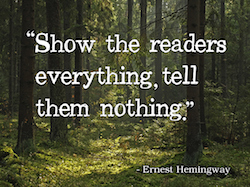
Good writers “show”, rather than “tell”, using imagery. When you show, you are being an artist, painting with words! A splash of colour and a dash of sound can be used to create powerful images.
Imagery is an important literary device that goes hand in hand with descriptive writing. Imagery is a vivid description that involves using the five senses and making careful word choices to show, not tell. You use your senses to create an image in the reader’s mind.
Your five senses are:
| Sight | Hearing | Touch | Taste | Smell |
Why Use Imagery?
- to generate a vibrant and graphic presentation of a scene that appeals to as many of the reader’s senses as possible.
 Which do you like better?
Which do you like better?
- Telling sentence: Mt. Cheam stands high above the Fraser River.
- Showing sentence: The wind whispers as it whirls around the majestic pyramid that is Mt. Cheam; the peak looms menacingly over the Fraser River that is casually winding its way to freedom through the grass-filled valley below.

- Telling sentence: I biked around the beautiful Stanley Park seawall.
- Showing sentence: Up and down, my legs pedaled me reluctantly forward on the seemingly endless seawall trail while my eyes sought out the fairyland trees and my ears absorbed the gentle lapping of waves as the ocean hummed its peaceful tune through the salty air.
What is the secret to "showing" a scene? Use imagery to create a picture.
- Specific details.
- Sensory details - sights, hearing, touch, or even taste or smells.
- Strong action verbs. (looms, winding, pedaled, sought, absorbed, lapping, hummed)
- Creatively applied adverbs. (menacingly, casually, reluctantly, seemingly )
- Interesting nouns.
- Tantalizing adjectives! (majestic, grass-filled, endless, fairyland, gentle, peaceful, salty)
These details project the reader into the scene to become a part of it. They can be used for "real objects" (such as a place) or abstract concepts, such as "creative thinking".
Have you ever been to an ocean beach in BC? A fishing village? The village of Tofino, BC? It is on the west side of Vancouver Island on the Pacific Ocean, where amazing surf, beaches, Orcas, and natural beauty draw tourists from all over the world, including surfers. I wonder what it would be like to live there? The first poem in today's lesson describes Tofino.
First Read: Click on the title to read the poem, Tofino, once, to get the gist of how it uses imagery.
Then, listen to the poem about Tofino, BC as you read along. Notice how the punctuation, not the lines, guides the reading.
Does the poem rhyme?
When a poem doesn’t rhyme, it is called a free verse poem.
Does the poem have stanzas?
- Free verse poems may be written in stanzas, but not always. The poem, Tofino, has no stanzas.
So what about the structure?
- In Tofino, the lines are part of the structure. Some free verse poems have stanzas that are part of the structure.
 |
Complete the responses in your Learning Guide. |
4.1D Show Don't Tell - Journey to the Fishing Grounds

Today, you will be reading and responding to a poem that shows everything and tells very little. Then, you will be a creative thinker and write your own a poem, using vivid imagery.
What is the secret to "showing" a scene? Use imagery to create a picture. Here's how:
- Specific details.
- Sensory details - sights, hearing, touch, or even taste or smells.
- Strong action verbs. (looms, winding, pedaled, sought, absorbed, lapping, hummed)
- Creatively applied adverbs. (menacingly, casually, reluctantly, seemingly)
- Interesting nouns.
- Tantalizing adjectives! (majestic, grass-filled, endless, fairyland, gentle, peaceful, salty)
These details breathe life into your writing and project the reader into the scene to become a part of it.
Do you have a favourite view? Do you have an activity that makes you think of certain smells and sounds? Or do you have a concept (like creativity) that can be described using sensory details?
In this lesson, you will visit another "show, don't tell" poem. Then you will try to write one of your own.
"Statl’limx Fishing: Night Air", was written by a First Nations' author who writes about connections to the land and creatures on it. If you've ever been to a First Nations' longhouse, Pow Wow, canoe race, or other event, you have probably tried smoked salmon - the subject of this poem.
 |
Complete the reading and responses as explained in the Learning Guide. Then return to this online lesson. |
Where Will You Journey Today?
Do you have a favourite place?
- A place where you feel at peace or are amazed at the splendour?
- A place your family has traveled to?
- An Okanagan beach?
- A Rocky Mountain retreat?
- Camping in Parksville?
- A ranch in the Cariboo region of BC?
- Even a waterslide or waterfall would be great choices!
Do you fancy somewhere exotic?
- A beach on Hawaii?
- A hike to ancient ruins?
- A country you've read about in social studies or seen in a documentary?
1. When you know what poetic journey you'd like to take your audience on, if possible, find a picture of that place (or even visit it if it is in your neighbourhood).
You know your purpose: To take the reader on a journey to _____________________, so let's go!.
Record your purpose in your Learning Guide and then continue the prewriting process:
2. Brainstorm words that describe your chosen location.
 |
Go to your Learning Guide now and follow the steps to unleash your creativity and "show, don't tell" abilities. Then, complete the "Poetry Reading Quiz". |
4.1E Creative Ways to Express Ideas: Simile and Metaphors
Did you complete the Poetry Reading Quiz? If not, go and complete the quiz now before continuing.
Why would an author want to compare two things that are different from one another?
If a writer really wants you to visualize the blue of the sea, he or she may compare the blue sea to sapphires. They are quite different, but share "blueness". Earlier in this course you learned:
Similes are a way to compare two things using the words like or as.
The blue sea gleamed like sapphires in the sun.
Why use these kinds of phrases?
- Similes, and other forms of figurative language, are like sunbeams through the forest that make readers go, “Oooooh! Aaaaaah!”
- They make writing more vivid and clear.
- They help to paint a picture with words that the reader can more easily see and feel.
Take a look at some similes in poetry. See how comparisons can be used to present feelings, images, or ideas in a fresh, often more powerful way!
Remember, a simile is a comparison using such words as "like" or "as". Here are some examples:
The villains looked as fierce as lions with their wild manes of hair and snarly looks.
The music burst like a pent-up flood.
Which of the following are similes?
The clouds are like galleons in the sky.
Ben’s temper was a volcano, ready to explode.
Her lips were as red as a wailing firetruck.
How do metaphors help us better understand the world? And, what makes a good metaphor?
Comparisons that are metaphors use the verb "to be". This means that one thing IS or WAS something else, or some things ARE or WERE something else. These clue words tell you that a comparison may be a metaphor.
Which of the following are metaphors?
The road was ribbon of moonlight.
The sky is a patchwork quilt.
The thunder roared like a mighty lion.
Simile and Metaphor in Music - Your Turn
 |
As you listen to the following songs, answer the questions in your Learning Guide |
4.1F The Wendigo

Oral Traditions
Today, you will read two poems about a Wendigo (also spelled Windigo). What is a Wendigo?
Among First Peoples, culture has been transmitted over generations through oral traditions - storytelling, songs, dance, carvings, and masks. Often, symbols or characters are designed to teach lessons. Sometimes, stories are told to help people to behave. The Wendigo is from oral traditions for the Algonquin peoples in Canada.
Before Reading
Connect: If possible, talk about the questions with your home facilitator:
- What stories do you know of that have been told to little kids to encourage them to behave?
- What "monster" or "spirit" fears do some little kids have? Did you think of the "bogeyman" or "the monster under the bed"?
- What is a Wendigo:
The Wendigo is an evil monster or spirit in some First Nation stories, known to appear as a monster with some characteristics of a human. Algonquin people who became overpowered with greed could turn into a Wendigo as punishment.
First reading:
Try to get the "gist" of the poem. This poem has a great rhythm so it is fun to read! Here are some words to refer to that may be unfamiliar and hard to define using context clues. Read these words before reading the poem:
- indigo - dark blue
- lurked - remain hidden so as to wait in ambush for someone or something
- loll / lolling- sit, lie, or stand in a lazy, relaxed way.
- lollop - move in an ungainly way in a series of clumsy paces or bounds (like a bear going along an uneven pathway)
Read the poem:
Second Reading:
Read it through a few times, trying to improve on:
- Expression and volume - Can you adjust your volume and tone of voice to show emotion and/or mood?
- Clarity and Enunciation - Can you speak (articulate) clearly, with good pronunciation so each word can be understood?
- Pace / Fluency – Can you speak smoothly and fluently, with few hesitations?
When you are feeling confident, read it aloud to your home facilitator. Talk together about what you did well and what you could improve upon.
Can you picture this creature? As you lay in your hammock it lollops (or ambushes) you! Not a happy ending!
 |
In your Learning Guide, rewrite or add to some of the lines using similes and/or metaphors. Use your imagination; try to visualize what this creature MAY be like, and be creative! |
Another Wendigo...
Wow! Can you picture the Wendigo (spelled "Windigo" this time) in the poem below? Good readers try to visualize what they are reading. This author makes visualizing easy!!!
You can sketch Sylvia Mark's Windigo, if you wish, as you read her Windigo poem. What literary device does it use? Read it for enjoyment.
Read the poem:
Your Writing Task:
Did you figure out what literary device was used throughout the last poem? It was full of similes so basically was a simile poem.
You will write a simile and metaphor poem about an emotion, a creature (real or mythical), an animal or pet, something you are passionate about, or even a poem about yourself (a poetic self-portrait).
Before beginning, let's watch three students present their simile and metaphor poems. Listen for the similes and metaphors! The first boy is a great presenter - he uses eye contact and gestures. The poem about soldiers is quite powerful!
Similes or Metaphors?
Frustration is like a viper squeezing my chest...
Frustration is a tornado ripping through a town...
Frustration is a red light....
Happiness is a smile spread across your face...
Happiness is like a cheer going through your soul...
Holding onto a weapon like it is a best friend...
 |
In your Learning Guide, follow the steps to complete your poetry writing task. |
4.1G Fossils and Creative Tools: Alliteration, Onomatopoeia, & Personification
What is Alliteration:
Example: "Seven sisters slept soundly on the sand."
- the repetition of the beginning sounds in neighbouring or nearby words.
- creates a pattern that is memorable and makes you pay attention.
- is fun to say and enjoyable to hear.
Where have you heard it before?
- Many familiar expressions use alliteration. These include "down in the dumps" and. "turn the tables."
- Tongue twisters use alliteration.: "rubber baby buggy bumpers.
- Advertising
- Many sayings such as these use alliteration:
- He who laughs last laughs first.
- Time and tide wait for no man.
Remember: Alliteration is a repetition of sound, not letters, so look carefully when trying to identify it.
Alliteration and Poetry
While reading the following poem out loud, imagine fossils and skeletons of extinct creatures having a rowdy and lively gathering. Can you find examples of alliteration in two lines of this poem?
(Written in 1949 to accompany one section of The Carnival of the Animals, an entertaining musical suite of fourteen songs.)
 |
Complete the alliteration activity in your Learning Guide. |
Listen to the music for which Ogden Nash wrote Fossils. Do you think the xylophone sounds like the "clatter of their bones"?
Onomatopoeia is a word that imitates the sound it represents.
How to pronounce onomatopoeia:
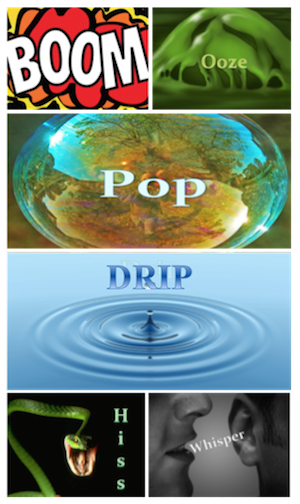 Examples:
Examples:
splash, wow, gush, kerplunk
Such devices bring out the full flavour of words. When these sound words occur, it is called onomatopoeia (a Greek word meaning name-making for the sounds literally make the meaning.)
Why use onomatopoeia in poetry? It is so descriptive and helps us to imagine what is happening.
More Examples of Onomatopoeia:
- Words related to air: flutter, gasp, swish, swoosh, whisper, whoosh, whizz, whip.
- Words related to animals: chirp, woof, purr, buzz, cluck, cock-a-doodle-doo, baa, hiss, meow, moo, neigh, oink, quack, ribbit, tweet.
- Words related to collisions and fights: bam, bang, boom, clang, clank, clap, clatter, click, clink, ding, slam, screech, slap, smash, thud, thump.
- Words related to the voice: chatter, blurt, giggle, growl, grunt, gurgle, mumble, murmur, belch, shiver.
- Words related to water: splash, spray, sprinkle, squirt, drip, drizzle, pitter patter, sloshes, plop.
Can you find one example of onomatopoeia in the excerpt from this poem?
“FOSSILS” by Ogden Nash
At midnight in the museum hall,
The fossils gathered for a ball,
There were no drums or saxophones,
But just the clatter of their bones...
 |
Complete the onomatopoeia activity in your Learning Guide. |
- The wind screamed out in sorrow to the moon.
The wind is not alive. It doesn't have a voice to scream with and it doesn't have emotions. Here are a few more examples.
- The friendly gates welcomed us.
- The Earth coughed and choked in all the pollution.
- The flowers danced in the wind.
Watch the video to learn even more about personification.
Can you find two - three examples of personification in this poem? This may be a little bit trickier than finding the alliteration and onomatopoeia.
“FOSSILS” by Ogden Nash
At midnight in the museum hall,
The fossils gathered for a ball,
There were no drums or saxophones,
But just the clatter of their bones,
Rolling, rattling carefree circus,
Of mammoth polkas and mazurkas,
Pterodactyls and brontosauruses
Sang ghostly prehistoric choruses,
Amid the mastodonic wassail I caught the eye of one small fossil,
“Cheer up sad world,” he said and winked,
“It’s kind of fun to be extinct.”
 |
Complete the personification activity in your Learning Guide. |
4.1H The Great Water Giant
In the poem below, see if you can find four examples of alliteration, six examples of onomatopoeia, and see if you can figure out how the entire poem is a personification? What do you think the "great water giant" actually is? What is this poem describing? An actual bath or something else?
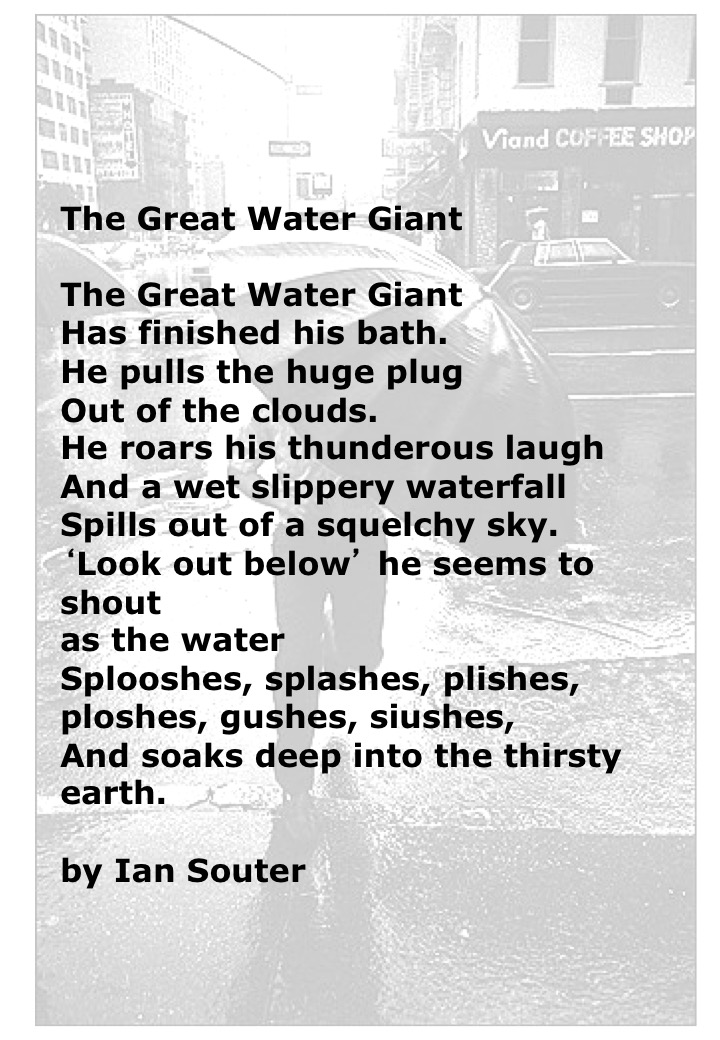
 |
Complete "The Great Water Giant" activity in your Learning Guide. |

Now that you understand alliteration, onomatopoeia, and personification, you can use them to write a poem of your own. You can decide whether your poem will rhyme (like Fossils) or be in free verse (like The Great Water Giant) and you can choose your topic.
1. Choose your topic:
- Weather conditions: rain, snow, wind, sun, lightning…
- Places or a non-human creature in a place: a city, a forest, a jungle, a riverbank…
- Natural elements: water, fire (leaps, springs…), air, night, sunrise, sunset
- An emotion: fear (grips, cries…), pain, joy, love
- An piece of equipment for an activity: sports ball (how would the ball describe scoring a goal/basket, meeting feet, nets, and posts, listening to the whistles), ribbon for rhythmic gymnastics, football, baton, piano keys, paintbrush, book
2. Brainstorm ideas.
3. Expand some of your ideas. If you start with a topic for which you can only think of a few ideas, you may need to change your topic.
To develop personification:
Think of action verbs for your ideas and then enhance them with creatively applied adverbs. Examples: The piano keys sang harmoniously… / The soccer ball attacked the net ferociously…
To develop alliterations:
Think of words you can substitute or add to develop ear-pleasing alliterations. A thesaurus can be very helpful for this. Examples: The piano keys sang the sweet sounds of harmony… / The soccer ball savagely attacked the net forcing the goalie to surrender…
 |
Follow the steps in your learning guide to complete your poem. Then, complete the Literary Devices Quiz. |
4.1I Building Creative Thinking Through Limericks
Did you complete the Poetry Reading Quiz? If not, go and complete the quiz now before continuing.
Creative Thinking
In this unit, you are building your "Creative Thinking Competency". This means you are working on the following:
- I can get new ideas or build on other people’s ideas, to create new things within the constraints of a form, a problem, or materials
- I can develop a body of creative work over time in an area I’m interested in or passionate about
- I deliberately learn a lot about something so that I am able to generate new ideas or ideas just pop into my head
- I can usually make my ideas work within the constraints of a given form, problem, and materials if I keep playing with them
- I build the skills I need to make my ideas work, and usually succeed, even if it takes a few tries
After understanding a pattern poem called a limerick, you will build on the ideas of others to create your own limerick.
What's a Limerick?
- Limericks are nonsense poems. They are fun poems - written to bring joy - and they are even more fun to write!
- Limericks are usually narrative poems because they tell a story.
- Limericks are rhyming poems, which means they are not free verse poems.
Where are limericks originally from?
- Limericks are believed to have originated in the town of Limerick, Ireland.
- Limericks were made popular by a rather sarcastic Mr. Edward Lear who lived from 1812 - 1888.
- Many Irish immigrants settled in Canada. Between 1825 and 1845, 60% of all immigrants to Canada were Irish; in 1831 alone, some 34,000 arrived in Montreal. Approximately 1.2 million Irish immigrants arrived from 1825 to 1970. With them came pieces of their culture, including limericks.
Patterns in Limericks
Read these limericks. What patterns do you notice? What do you like about them? Are they serious or humourous?
-------------------------------------
There was an Old Man with a beard,
Who said, "It is just as I feared!
Two owls and a hen,
Four larks and a wren
Have all built their nests in my beard."
By Edward Lear
(Source: Prelutsky, J., & Lobel, A. (1983). The Random House Book of Poetry for Children. New York, NY: Random House.)
-------------------------------------
I raised a great hullabaloo,
When I found a large mouse in my stew.
Said the waiter, "Don't shout
And wave it about
Or the rest will be wanting one, too."
By Anonymous
(Source: Prelutsky, J., & Lobel, A. (1983). The Random House Book of Poetry for Children. New York, NY: Random House.)
As you read the next two limericks, look for patterns. You may already have discovered a few limerick patterns.
|
Limerick One: A bull-voiced young fellow of Pawling, Competes in meets for hog-calling, The people applaud, The judges are awed, But the hogs find it simply appalling. - By Morris Bishop (Source: Prelutsky, J., & Lobel, A. (1983). The Random House book of poetry for children. New York, NY: Random House.) |
Limerick One: Number of lines: Lines that rhyme with line one: Lines that rhyme with line three: |
 |
In your Learning Guide, complete the analysis of "Limerick Two". |
Did you find the rhyming pattern?
Lines one, two, and five end with rhyming words.
Lines three and four end with rhyming words.
This is called an AABBA rhyming pattern. "A" stands for the first rhyming sound (lines one, two, and five). "B" stands for the second rhyming sound (lines three and four).
A canner exceedingly canny, (A)
One morning remarked to his granny: (A)
"A canner can can (B)
Anything that he can, (B)
But a canner can't can a can, can he? (A)
Here is a quick video on labelling rhyme schemes. Knowing this will help you to see if your limerick truly fits the limerick pattern.
 |
In your Learning Guide, label the rhyming pattern (A) and (B) on each line in "Limerick Two". |
Syllable Patterns
Limericks have a syllable rhythm pattern that helps to make them fun to read - almost like a song. Simply put, the syllables go like this:
da-DA-DA-da-DA-DA-da-da
da-DA-DA-da-DA-DA-da-DA
da-DA-DA-DA-da
da-DA-DA-DA-da
da-DA-Da-da-DA-Da-da-da
Limericks usually have eight or nine syllables in lines one, two, and five (although they may have ten).
Limericks usually have five (or sometimes six) syllables in lines three and four.
When you read limericks out loud, you can feel the rhythm in the lines!
Here is another example. What movie is it based on?
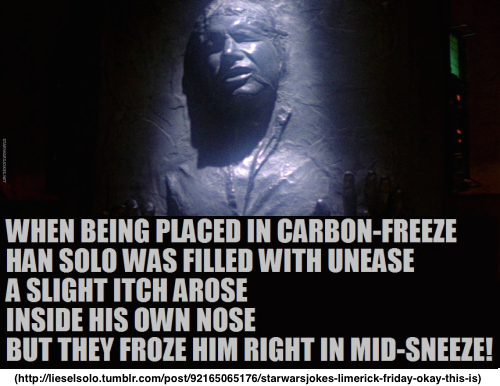
 |
In your Learning Guide, complete "Syllables in Limericks". |
Poetry Writing Task 4 - Limerick

Step One:
An easy way to begin to write a limerick of your own is to use a name in the first line. You can use your own name, the name of your town or a place, or another name that is easy to rhyme, like Jabba the Hutt.
For example: There once was a young boy named Brian / There once was a young girl named Anna / There once was a kid from Vancouver (hard to rhyme) / There once was a girl from a mountain
Step Two:
Brainstorm rhyming words for your first line - you will quickly see if you can think of "good rhymes" to use:
| Brian | Anna | Vancouver | Mountain |
|
Flyin' Fryin' Cryin' Sighin' Complyin' |
Banana Bandana Piana Savannah Americana Cabana |
Hoover Mover Prover Louver Maneuveur |
Fountain Count in |

Step Three:
Continue to write your limerick following the pattern.
Line one: (8 or 9 syllables, Rhyme "A") There once was a
Line two: (8 or 9 syllables, Rhyme "A")
Line three: (5 or 6 syllables, Rhyme "B")
Line four: (5 or 6 syllables, Rhyme "B")
Line five: (8 or 9 syllables, Rhyme "A")

Did you use an AABBA rhyming pattern? This means the end of lines one, two, and five rhyme with each other. This also means the ends of lines three and four rhyme with each other.
Does your limerick have the proper number of syllables?
Is it original and creative?
 |
In your Learning Guide, complete the Writing Task: Limerick. |
4.1J Quatrains
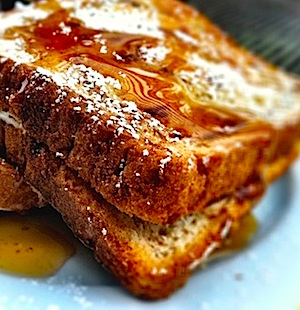
Before we begin this lesson, I would really like to tell you about breakfast today.
French toast, smothered with honey,
Delicious to taste and munch,
Taste of cinnamon, light and sunny,
Dances in my mouth with each crunch.
(Source: https://ericarosenblum.files.wordpress.com/2011/10/quatrain-poem2.pdf)
Can't you just picture the delicious breakfast? The imagery (sight of the toast smothered with honey, sound of the munch and crunch, taste of cinnamon dancing in the mouth) creates a tantalizing quatrain poetry dish!
A quatrain is a stanza (also know as verse) with four lines and a rhyme scheme. Although a quatrain is only one stanza, a quatrain poem can have any number of stanzas (including one). As a bonus, the rhyme schemes can be extremely varied.
But what is a rhyme scheme? A rhyme scheme is the rhyming pattern in a poem.
| A poem might rhyme every line. |
My family has a crazy cat (http://www.poetry4kids.com/blog/lessons/how-to-write-funny-poetry-chapter-2/) |
| A poem might rhyme every second line. |
Hercules avoided (http://www.poetry4kids.com/blog/lessons/how-to-write-funny-poetry-chapter-2/) |
| A poem might rhyme the first and third line one way, and the second and fourth line another way. In this poem, blue rhymes with new (lines one and three) and sun rhymes with outdone. (lines two and four) |
A hummingbird necklace of gold and blue, |

The theme in a story, movie, or poem is its underlying message, or big idea. It is the critical belief about life that the author is trying to convey. Through themes, a writer tries to give his readers an insight into how the world works or how he or she views human life. Here is an example of theme (from http://literaryterms.net/theme/):
A man, fueled by an urge for power and control due to his own pride, builds a supercomputer. That supercomputer then takes over the world, causing chaos and struggle galore.
This sci-fi style story contains many common themes. A few of its themes include:
- Danger of excessive pride
- The risky relationship between humankind and developing technology
To find a theme, you, the reader, need to think! You need to draw conclusions and infer what the author is trying to express about the topic.
How is the theme different from the topic?
A poem’s subject is the topic of the poem - what the poem is about. Themes are usually about big ideas or topics - love, war, freedom, friendship, good vs. evil. The theme is an idea or belief that the poem expresses about the subject or uses the subject to explore, its message about life and how people behave. It is the statement about society, the world, or human nature. Theme is the POINT being made about the topic. Theme is a STATEMENT or LESSON about life.
Examples of Topics Vs. Themes:
Read the chart to see some examples of theme statements ABOUT topics.
|
Topic: Revenge Theme: Be careful how you treat others. They may treat you the same. |
Topic: Courage Theme: Face your fears and you can defeat them. |
|
Topic: Dreams Theme: Hard work can help you get what you want in life. |
Topic: Jealousy Theme: Don't wish for what others have. Be happy with what you have. |
To find the theme, think:
- What is the topic?
- The topic is....
- What does the poem say about the topic?
- The poem says...
- What do these things tell us that are important to learn about life?
- The poem tells me it is important to ........
Read through the following poem to get the gist of the poem. What is it about? What important message does the author have for the reader? What is the theme?
 Before you read, here are a few words to know:
Before you read, here are a few words to know:
- scorn - belief that someone is worthless or despicable
- avarice - extreme greed for riches
- blights - something that frustrates plans or hopes
- wretchedness - extreme misery
I Dream A World
By Langston Hughes
I dream a world where man
No other man will scorn,
Where love will bless the earth
And peace its paths adorn
I dream a world where all
Will know sweet freedom's way,
Where greed no longer saps the soul
Nor avarice blights our day.
A world I dream where black or white,
Whatever race you be,
Will share the bounties of the earth
And every man is free,
Where wretchedness will hang its head
And joy, like a pearl,
Attends the needs of all mankind-
Of such I dream, my world!
(Source: http://www.learningfromlyrics.org/Langstons.html)
 |
Go to your Learning Guide and complete the First Read response to this poem. |
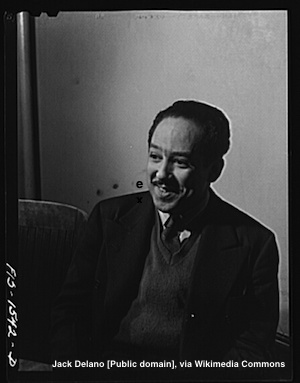
The perspectives of authors is often influenced by family, friends, gender, and life experiences. Messages sometimes reflect the society or culture around them.
Langston Hughes (pictured here) was an American writer who lived from 1902 - 1967. He lived during a time when African American people were striving for equality. Hughes' father was a wealthy man who was half African - half White. Despite African American history of capture from Africa and slavery in America, Langston Hughe's father had strong beliefs and blamed African Americans for their troubles.
Langston Hughes, the author of I Dream A World, was not pleased with his father's attitude or beliefs of blaming the African American's themselves and wrote this poem to share his dream of a peaceful and just world.
Second Reading:
Remember, this is a slower read, to try to understand the poem better. Explore the poem again using your reading powers!
- Make connections. (Think: This poem reminds me of....) If you can connect to what you already know, it will be easier to understand what you are reading.
- Question the text. (Think: I wonder..., What if..., What was the author really trying to say?
- Infer. (Think: Probably, Most likely, It seems as though...)
- Visualize. (Think: What would this look or be like? What does the author want me to picture?)
Annotating the poem can help readers to collect their thoughts, inferences, connections, questions, and ideas. Remember, annotating looks like this (the blue text beside the poem).

 |
In your Learning Guide, complete the Second Read by annotating the poem, I Dream a World. This means that you can record your connections, questions, inferences, visuals, and even ideas about the poem. Then, complete the Third Read to find the theme. |
4.1K Building Creative Thinking Through Quatrains
 What do you dream of? Your wishes? Your hopes for the future?
What do you dream of? Your wishes? Your hopes for the future?
- for yourself
- for your family
- for children
- for animals
- for the environment
- for the arts
- for science, technology, or nature,
- for your country or the world.
How are people's dreams impacted by the personal experiences and background?
- A teacher may have this dream: "I dream a world where powerful books capture children."
- A United Nations leader may have this dream: "I dream a world where the rights of the child are for every child."
- A health worker may have this dream: "I dream a world where no child goes without exercise every day."
What are you passionate about? What would you like to see improved in your world or the world around you? What "causes" do you know of?
Your task is to write a quatrain poem about one or more of your dreams. You can write three or more stanzas and you can use one theme for the entire poem or one theme for each stanza.

TOPIC:
Brainstorm ideas of what dream you could write about.
Each stanza might start with "I dream a world where _______" like Langston Hughes poem or you may choose your own words.
THEME:
After you have chosen one or more topics, think of your theme or themes. What do you want the readers to "think" about the topic? What important message do you want to give?
BRAINSTORM:
Brainstorm what the world would be like, what would be different, what people or creatures would do differently. Put your ideas in a list or a web.
(Of course, if you have another topic for your quatrain and are feeling inspired, you may use your topic instead.)
 |
In your Learning Guide, complete your Prewriting and Drafting tasks. Then follow the steps below to complete your writing. Finally, complete the "Reflection" in your Learning Guide. |

Make changes to improve your writing. Remember, poetry uses purposefully powerful words to cause a reaction.
- Does each stanza have a consistent rhyme scheme? ABAB, ABCB, AABBCan you add simile, metaphor, alliteration, or personification to enhance your poem?
- Try a few versions of some of your lines to make the rhyme scheme consistent.
- Can you improve your use of imagery to create a picture?
- Where can you add specific details?
- Can you revise to add or substitute stronger action verbs? (looms, winding, pedaled, sought, absorbed, lapping, hummed)
- Can you revise to add or substitute creatively applied adverbs? (menacingly, casually, reluctantly, seemingly)
- Can you revise to add or substitute more interesting nouns?
- Can you revise to add or substitute more tantalizing adjectives? (majestic, grass-filled, endless, fairyland, gentle, peaceful, salty)

Patrol your writing for CUPS (capitals, usage, punctuation, spelling). Make corrections as needed.

The next step in the writing process is "Evaluating". In your Learning Guide, think and talk about the evaluating questions with your home facilitator. Decide how well you think your draft meets the criteria. Revise and edit your poem more, if you feel it is needed.

The last step is "Publishing". This step will be completed in your Reading Projects. For now, this lesson and poem are completed. Congratulations!

Do you have someone you can share your poem with now?